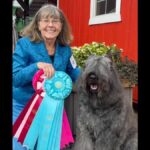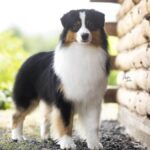Interview with Anne Jahelka, Breeders of Belleterre Brussels Griffons
- Please tell us a little bit about yourself. Where do you live? How many years in dogs? How many years as a breeder? What is your kennel name?
- What is your “process” for selecting show puppies? Performance puppies?
- In your opinion, is your breed in good condition overall? Any trends that warrant concern?
- As a Preservation Breeder, can you share your thoughts on the sport today? How’s the judging these days? What do you think about the number of shows?
- In your opinion, is social media good for the sport? Is it harmful?
- What are the biggest challenges facing the dog show community as a whole today and how can these be addressed?
- What are some of the positive changes you’ve seen in the sport over the past decade?
Anne Jahelka
1. I’m originally from England, but have also lived in Canada when I was growing up. My parents had Great Danes, a breed I dearly love. My husband and I currently live in Tennessee, having moved here from Washington State in 2004. I have bred Danes, Cardigan Welsh Corgis, and German Shepherd Dogs in the past, but the past 29 years have been dedicated primarily to the Brussels Griffon. Our kennel name is Belleterre. Back in the 1960s, I first exhibited a German Shepherd Dog I’d purchased. I was mortified to have been told he was a pet after I’d showed him a few times, but grateful to the person who plucked up the courage to tell me. I was lucky enough to bring a Brussels Griffon puppy from England several years ago who became the top-winning Brussels Griffon in the history of the breed, CH Cilleine Masquerade, “Lincoln.” He is gone now but we see him still in his progeny.
2. Any puppy going to a show or performance home must first of all be sound. Parents are health tested and the puppies are examined by a vet every time they go in for their puppy vaccinations and again before they leave. Good eyes and good patellas are absolutely required for a start. Temperament is, of course, very important. A puppy must be happy and outgoing if it is to perform. Our puppies do very well with Dr. Carmen Battaglia’s “Super Dog” method of early neurological stimulation. Pat Hastings’ recommendation of a puppy being on seven different surfaces, having played with seven different types of objects, been in seven different locations by the age of seven weeks is another good tool. Lastly, as the puppy matures, we look hard at their conformation at eight weeks of age and again at twelve weeks. Twelve weeks of age is the minimum age our puppies are placed, but for a show prospect they may stay with us a little longer. A correct head, strong pasterns and hocks, strong topline, and good tail set are a must for a start and then we look at angles and movement. For a rough coat puppy, we look for a harsh coat with good color. A smooth coat should be tight and well pigmented.
3. I feel that our breed is currently in a good place. People are becoming more aware of possible health issues and are health testing more than they did years ago. Temperaments seem more stable. I think, overall, the size of our Griffons has increased. I’d like to see them a little smaller. My own dogs are mostly at the upper end of the recommended size, but great movers. That’s something I’d like to improve in my own breeding program. That said, I’d rather see a larger specimen with correct movement than a tinker toy with poor movement.
4. I think the judging these days is mainly good. We seek out those judges who really seem to know and understand our breed and reward the dog on its merits rather than who is on the other end of the lead.
5. Regarding social media, I think it’s good for the sport. We can watch breeds and shows that we may not have been able to attend in person. We can see dogs from other parts of the country. We can hear all those opinions! There’s a lot of ideas, education, and thoughts to be discovered through social media.
6. I think one of the challenges facing the dog show community at this point is the lack of majors. Low entry breeds often have to travel out of state to have a chance at a major. With the price of gas right now, that can be a major obstacle for those with larger vehicles, and then there’s the cost of food and lodging. Employing a handler is one way to ensure finishing a dog. The handlers travel to various shows and certainly can get the job done and done well, but for some people, going to shows and enjoying the company of their friends and other competitors is an important part of the show experience. Also, showing your own dog and winning is a definite high. Many venues now offer on-site eye testing, x-rays, and semen collection, which is also a plus.
7. I like the fact that AKC is now offering many more performance events than in past years. There seems to be a sport available in which any breed of dog (or type of owner) can excel. Many Conformation exhibitors are now adding Performance titles. It’s good to see people working and having fun with their dogs.









